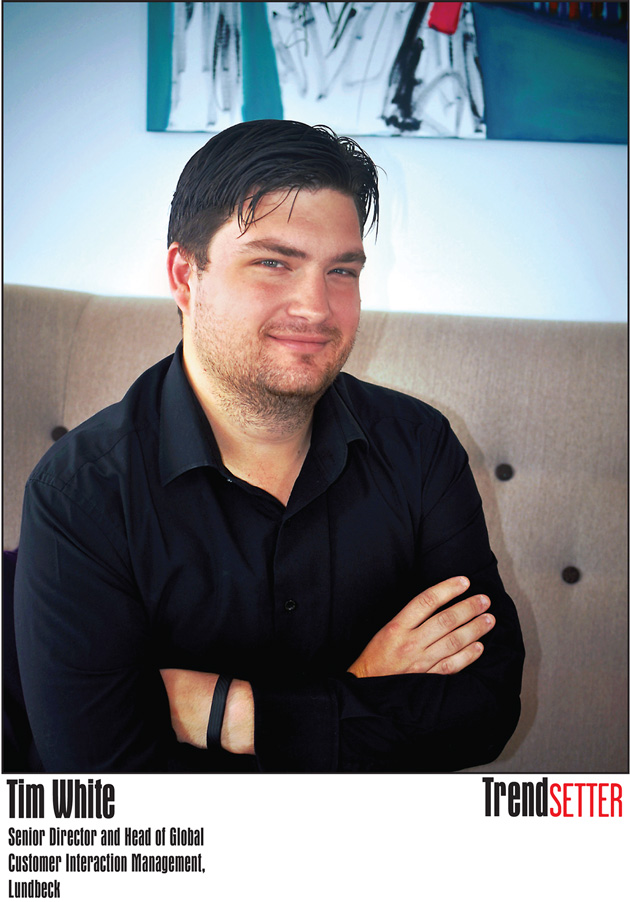Since 2006, Tim White has helped pharma companies improve their customer interaction and digital communications by incorporating his experience in the music industry. He started his pharma career at Merck where he developed digital strategies beyond the brand.com website, before moving on to Novartis where he modernized their sales approach in the European region. In February 2013, he joined Lundbeck, a Danish pharmaceutical company that specializes in neurology and psychiatry, where he is working to improve the way the pharma company communicates.
PM360: What is it like to work for a company like Lundbeck?
Tim White: For me, it’s a really interesting company to work for, only because of the place that we’re in right now. I came from big pharma, so to work for a company that is preparing to launch three novel treatments is very exciting. I wouldn’t go as far to say it’s a startup feel, but it almost has that type of energy to it.
How is it different from the big pharma companies you worked for?
You tend to be pretty close to decision-makers and you’re also empowered as a decision-maker. On a regular basis I get to work with my manager, who is our global head of product strategy, CFO or CIO. In big pharma, you get a steering committee check-in point with senior management once every two months or so and no ability to share and develop ideas with them.
You lead a group called Customer Interaction Management. Can you describe what you do?
What I look at is not what we’re communicating about our brands or our corporate image, but how we communicate it. We look at digital and social multi-channel marketing, preparing the sales reps for the changing role that they’ll play in the future of our industry, and finally, our congress and event presence. We examine how we can be leaders in leveraging all these channels to ensure a great customer experience. We also recognize the game-changing role that technology plays—especially the cloud and how cloud providers like Veeva can enable more personalized communications across all channels.
You came to pharma from the music industry. Did you bring along any insights about how to approach consumers that pharma wasn’t using?
When I came to Merck, I was shocked to walk into the situation and find out this iconic company’s approach to online. At the small niche jazz record company, we did relationship marketing and tried to understand the buying behavior and preferences of our customers. At Merck, we were basically putting up bar charts showing an upward motion on a website.
I think back to that moment a lot—I realized this is an area where experience and information—sent to both the patient and the healthcare professional—is so valuable. This is about peoples’ lives and well-being; they deserve a great experience, customer service and information through these channels. So I certainly bring everything that I did back then—and what I do in my personal social media life—into our current strategy.
Social media is still a touchy point with some pharma companies. How does your company approach it?
When I came in, I very specifically didn’t just jump right in and say, “We need to be social and make that the No. 1 priority.” Instead, I positioned it strongly as a second or third priority—there can be a lot of resistance until people understand social. The first step is education, then getting out into the markets to talk to customers and seeing what competitors are doing. Now, we’re developing our “empowered social media vision” and roadmap and then, the guidelines we’ll need. We work cross-functionally—not just in sales and marketing—but with recruitment, clinical trials and all areas. The goal is to first understand what Lundbeck wants to be as a social organization.
I know you work overseas. How is it different dealing with doctors in Asia than in the U.S. or Europe?
The Asian markets have more trust in branded content—in Europe there’s more cynicism towards pharma. Asian doctors also increasingly use technology at the point of diagnosis. I visited a specialist in Shanghai who showed me apps she used daily for help with diagnoses. It was eye-opening. We’ve imagined the world headed this way in a few years, but to see it there firsthand was impressive.
That is interesting. What were the apps like? Who designed them?
They were all in Chinese, so that was the first hurdle to overcome. But the core app came from a local Chinese generics company. As a generics company their portfolio was much broader—not one-product specific. She could enter information on the app and out would pop, “Here’s our recommendation on dosing.”
Again, these physicians respect content from the large Western pharma companies—they see it as a quality check. So we have the space to play there that we wouldn’t have in countries that feel pharma has credibility issues.
Then what should pharma do to find success with apps and other value-added services in countries that believe it has credibility issues?
My honest opinion about value-added services: The wording comes across a bit wrong. I’ve heard brand managers say, “Build me a value-added service for my product,” not realizing a value-added service is itself a product. The companies that are going to do this well must see it as such—and as a core company asset.
But in the U.S., companies such as Medscape give pharma the opportunity to be involved—but it doesn’t happen overnight. You need to provide that information and those services early on to avoid a trust issue.
The other side of this is advocacy. The amount of info patients are sharing on Twitter and Facebook is amazing. We owe it to them to engage and provide them with a voice. It may sound like an overly noble cause, but it’s something that we’re quite proud of trying to achieve.
What inspired you to want to achieve this noble cause?
I’m a firm believer in the Simon Sinek Golden Circle that says: People don’t buy what you do, they buy why you do it. That’s something I discussed with Lundbeck during their intensive interview process with two full days of interviews, in which the common thread among all those I spoke with came down to one thing: Patient centricity.
I came away with the notion that while we’re a business, people here are working for a cause—addressing mental health issues—that other companies have dropped out of. Lundbeck, however, is staying in this. From my first day, patients have been speaking on a regular basis in our commercial meetings—that sheds light on why you would want to join a company like Lundbeck.






